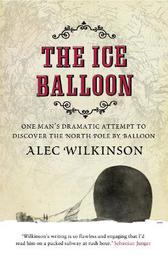
|
The Ice Balloon
Paperback / softback
Main Details
| Title |
The Ice Balloon
|
| Authors and Contributors |
By (author) Alec Wilkinson
|
| Physical Properties |
| Format:Paperback / softback | | Pages:288 | | Dimensions(mm): Height 198,Width 129 |
|
| Category/Genre | Historical geography
Geographical discovery and exploration |
|---|
| ISBN/Barcode |
9780007460038
|
| Classifications | Dewey:910.9113 |
|---|
| Audience | |
|---|
|
Publishing Details |
| Publisher |
HarperCollins Publishers
|
| Imprint |
Fourth Estate Ltd
|
| Publication Date |
28 March 2013 |
| Publication Country |
United Kingdom
|
Description
The story of the only person to attempt to reach the North Pole by balloon, and the golden age of Polar Exploration. In August 1930, a Norwegian sloop, sailing in the Arctic Ocean, stopped at a remote island called White Island. Landing, the sealers followed some walruses around a point of land. A few hours later, they returned with a book, together with a boathook stamped 'Andree's Pol. Exp 1896'. Not far from the boat was a body. It was leaning against a rock, with its legs extended, frozen. They carefully opened the jacket the corpse was wearing, and when they saw a large monogram 'A'. They knew who they were looking at: S. A. Andree, the Swede who, with two companions, ascended on July 11, 1897, in a hydrogen balloon to discover the North Pole, one of the last unmapped continents on earth. The Ice Balloon is their story and that of this last heroic age of polar exploration. Of the thousand or so people who had gone looking for the Pole before the twentieth century, at least seven hundred and fifty of whom died, only Andree used a balloon. Andree had ascended on a blustery afternoon from Dane's Island, in the Spitzberg archipelago, six hundred miles from the Pole. It took an hour for the balloon, which was a hundred feet tall, to disappear from the view of the people who were watching from the shore, carpenters, technicians, members of the Swedish navy who had assisted in the weeks leading up to the launch. Two years of planning had led him to predict that he would arrive at the Pole in about forty three hours. Ideally, he said, and perhaps disingenuously, he would descend in San Francisco. He was a figure of international glamour. Every newspaper of substance in Europe and North America carried word of his leaving. 'The most original and remarkable attempt ever made in Arctic exploration,' a British military officer called the voyage, in the age of the great explorer such as Nansen, Admundsen, Scott and Shackleton, comparing him, for novelty and daring, with Columbus. Then he vanished, the first person to disappear into the air.
Author Biography
ALEC WILKINSON began writing for The New Yorker in 1980. Before that, he was a policeman in Wellfleet, Massachusetts, and before that he was a rock-and-roll musician. He has published nine books, including The Happiest Man in the World and The Protest Singer. His honours include a Guggenheim Fellowship, a Lyndhurst Prize, and a Robert F. Kennedy Book Award.
Reviews'Wilkinson's writing is so flawless and engaging that I'd read him on a packed subway at rush hour.' Sebastian Junger 'The Ice Balloon tells a remarkable story, while also allowing those of other explorers and their ill-fated expeditions to float gracefully through its pages' Carl Wilkinson, Financial Times 'It does take a writer of Wilkinson's diligence of research, elegance of style and perfect pitch as a storyteller to give a doomed, forgotten hero a fine memorial to his heroic adventure in the golden, amateur age of polar exploration' Iain Finlayson, The Times 'Wilkinson writes with insight and flair, artfully interleaving Andree's story with a brief history of Arctic exploration ... his prose style suits the spare polar landscape, making his occasional poetic touches even more effective ... He understands that the value of polar stories lies in our endless love of discovery and the drama of being human.' Sara Wheeler, New York Times 'An elegant history of Arctic exploration' TLS 'Some engaging material here' Sunday Telegraph, Melanie McGrath 'If Wilkinson does not add much that is new to the story, he re-tells it with panache and compassion' Joanna Kavenna, Spectator
|